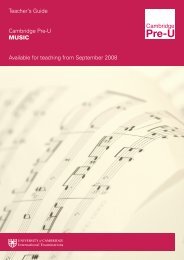Cambridge Pre-U Syllabus - Cambridge International Examinations
Cambridge Pre-U Syllabus - Cambridge International Examinations
Cambridge Pre-U Syllabus - Cambridge International Examinations
Create successful ePaper yourself
Turn your PDF publications into a flip-book with our unique Google optimized e-Paper software.
48<br />
<strong>Cambridge</strong> <strong>Pre</strong>-U Draft<br />
Sub-skill<br />
Decisions about measurements or observations<br />
While carrying out an investigation, candidates should be able to:<br />
• decide how many tests, measurements or observations to perform;<br />
• make measurements or observations that span the largest possible range within the limits either of the<br />
equipment provided or of the instructions given;<br />
• make qualitative observations and/or quantitative measurements that are appropriately distributed within<br />
this range;<br />
• decide how long to leave experiments running before taking readings;<br />
• replicate observations, readings or measurements as necessary;<br />
• make and record sufficient, accurate measurements and observations.<br />
Candidates may need to choose how many tests, measurements and observations can be made in the time<br />
available. In some experiments a regularly-spaced set of measurements will be appropriate. For other<br />
experiments, such as those requiring the peak value of a curved graph to be determined, it may be<br />
appropriate for the measurements to be concentrated in one part of the range investigated. Candidates will<br />
be expected to be able to identify the most appropriate distribution of values. In qualitative experiments,<br />
precise descriptions and comparisons of colour or other observations are expected.<br />
In experiments, such as those involving enzymes:<br />
initial rate of reaction may be measured (in which case measurements should be conducted as quickly<br />
as practicable);<br />
the rate of reaction might be expected to be constant over several minutes, or colour changes may take<br />
several minutes to occur, in which case leaving the experiment to run for as long as possible may be<br />
appropriate;<br />
an end point may be sought, in which case, candidates should expect to run the experiment until the<br />
end point is achieved or the time runs out.<br />
Repeated readings of particular quantities are often necessary in Biology, where experimental errors and<br />
variation in the activity of biological materials are large and an average value would be more representative.<br />
Individual readings or observations should be repeated where they appear to be anomalous. It may be<br />
necessary for the candidate to decide how many times to let something that is repetitious occur before<br />
recording the observation (e.g. in counting the number of bubbles released from a delivery tube).

















